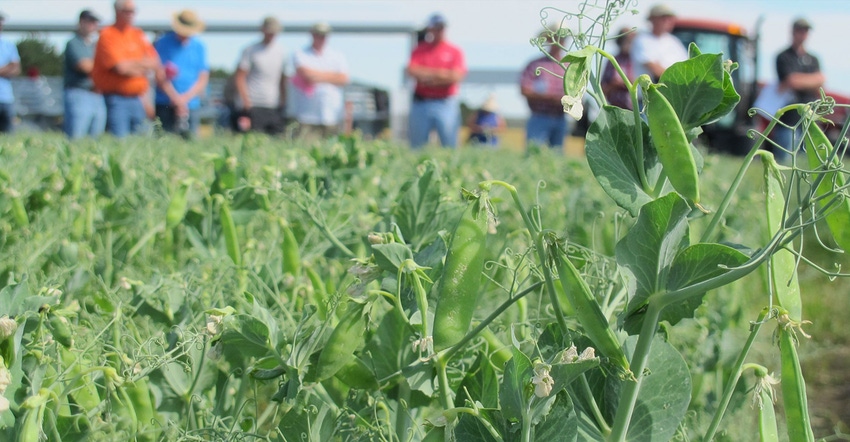June 19, 2018

Pulse crops like yellow field peas have been gaining traction in Nebraska — largely for the added value they bring to the rotation. In western Nebraska, field peas have taken hold as an alternative to the wheat-fallow rotation.
Although field peas may transpire water, they do so earlier in the season and less than other crops. Meanwhile, even fallow acres lose some water to evaporation, and field peas return a potential profit. In the central part of the state, the benefit lies more in the potential yield boost they provide to the following wheat crop.
However, there's also a soil health benefit. For the last several years, Strahinja Stepanovic, Nebraska Extension educator, has been researching yellow field peas in a rotation with wheat. This involved comparing the two rotations in plots at the Stumpf Wheat Research Center near Grant, measuring water infiltration in both rotations, microbial activity and nutrient cycling.
One of the first benefits growers realize, Stepanovic notes, is the large, fibrous root system.
"A lot of people say the ground is so mellow planting into pea stubble. That's because they have very fibrous roots. Field peas have a similar root mass to soybeans. But in peas, you have a larger root surface area," Stepanovic says. "A lot of people talk about using tillage radish to improve infiltration, but I think fibrous roots are equal if not more effective at improving soil properties. If you think breaking compaction, those fibrous roots penetrate into soils that larger-rooted cover crops can't."
And it doesn't take long to realize this improvement to infiltration. After just one year of field peas in the rotation, Stepanovic notes the infiltration improved compared to the wheat-fallow rotation, using the Natural Resources Conservation Service soil infiltration test, where water is poured over a portion of the plot to measure infiltration.
After harvest, the time needed to infiltrate 0.4 inch of water until 50% of soil was exposed was 174 seconds for fallow treatment and 87 seconds for the field pea treatment, a 50% faster soil infiltration rate with field peas in the rotation.
Microbial activity also improved in the field pea rotation. Solvita tests conducted in the fall after wheat planting and in the spring showed higher soil microbial activity in areas of the field where field peas were grown, although the test didn't differ between field pea and fallow after wheat harvest.
The Solvita test conducted on Oct. 16, 2015, showed carbon dioxide respiration levels of 52.27 parts per million in areas where field peas had been planted, and 27.72 ppm in fallow areas. The test on March 16, 2016, showed levels of 71.63 ppm in areas with field peas, compared to 59.74 ppm in fallow areas. Greater carbon dioxide respiration indicates greater microbial activity in the soil.
"Respiration is from microbes breaking down sugars so you can use that sugar for energy. Sugar is a carbon component and has energy attached to it," Stepanovic says. "If there's CO2 being released, you have more microbes in the soil, and they're more active. They're going to start multiplying, breaking down the residue, you have more nitrogen released."
But the microbial population is also more diverse in a more diverse rotation, he adds. Analysis showed at least three microbial species in wheat after field peas, compared to a single species in wheat fallow. In addition, analysis showed an average of 16.5 mycorrhiza spore in the pea rhizosphere, compared to an average of eight spores in the fallow plots.
What about nitrogen credit? It might be easy to assume that, as a legume, field peas provide a certain nitrogen credit to the following crop. But, as Stepanovic notes, the amount of nitrogen left in the soil for the following crop is about more than just fixation from rhizobia in legumes.
"We started with 20 pounds of N in the soil, but after we harvested peas and went into wheat, we had 65 pounds. So, you could say 40 pounds behind peas for the following wheat crop. But here's the deal: In fallow, we also had 65 pounds of nitrogen for the following wheat crop," Stepanovic says. "Where did that N come from? It didn't come from peas; it was mineralization of organic matter. If you don't have anything growing there using nitrogen, you'll have a nitrogen credit. The same is true for peas."
However, field peas might provide a greater nitrogen credit than soybeans, he adds.
"Soybean seeds have 40% protein. Peas have 25%, and therefore have less nitrogen demand than soy. Soybeans have got to get that N from somewhere. So, they're aggressive and start to scavenge it when they don't have the supply from nodules, and fixation declines going into the reproductive stages," he says. "Peas are a short-season crop. They don't have as much time to scavenge N from the soil. If they inoculate well, a large portion of their N will come from fixation. That means they leave more for the next crop."
You May Also Like




